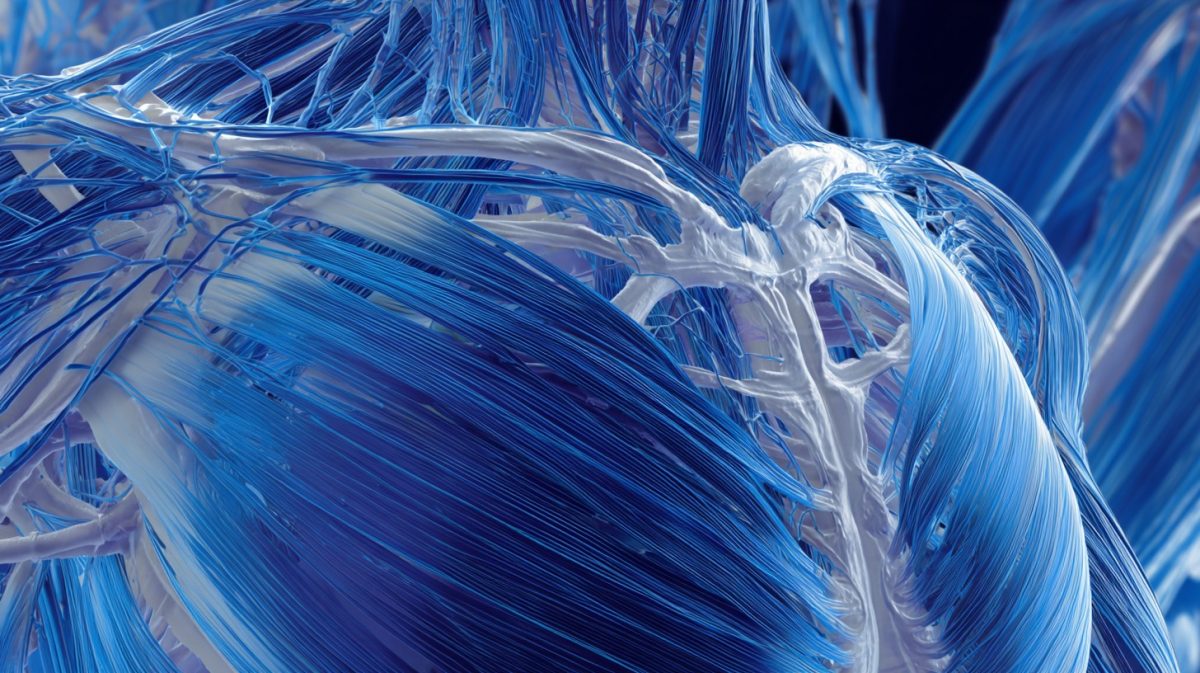For years, massage therapy focused primarily on muscles. We learned anatomy by memorizing individual muscles—trapezius, latissimus dorsi, gluteus maximus. But there's an entire system in your body that we're only beginning to fully understand, and it changes everything about how I approach treatment: your fascia.
If you've never heard of fascia, you're not alone. But once you understand it, a lot of things about your body will suddenly make sense.
What Is Fascia, Anyway?
Fascia is the connective tissue that wraps around every muscle, organ, nerve, and blood vessel in your body. Imagine a three-dimensional spider web that runs continuously from your head to your toes, connecting everything to everything else. It's not just wrapping—it's a living, communicating system that plays a crucial role in movement, posture, and pain.
Under a microscope, healthy fascia looks like a fishnet stocking—organized, with space between the fibers. But when fascia gets tight, dehydrated, or restricted, it becomes dense and matted, more like a piece of felt. This happens from injury, surgery, poor posture, repetitive movements, inflammation, or even emotional stress.
Why Your Pain Might Not Be Where You Think
Here's where fascia gets really interesting. Because it's one continuous system, restriction in one area can create pain or dysfunction somewhere completely different. That shoulder pain might actually be coming from fascial restriction in your ribcage. Your knee problem could be related to tight fascia in your hip. Your headaches might originate from fascial tension in your upper back.
This explains why sometimes I'll work on an area that seems unrelated to your complaint—because I'm following the fascial lines of tension through your body. Traditional muscle-based massage might miss these connections entirely.
Fascia and Chronic Pain
Research is showing that many cases of chronic pain aren't actually muscle problems at all—they're fascial restrictions. When fascia gets tight, it compresses nerves, restricts blood flow, and limits movement. Over time, this creates compensatory patterns where other areas of your body try to make up for the restriction. Before you know it, you've got pain in multiple areas, and the original cause is buried under layers of compensation.
Fascial restrictions can also create what I call "the body armor effect." When you've been in pain for a long time, your fascia tightens protectively around the area. It's trying to help, but instead it creates more restriction and more pain. Breaking this cycle requires addressing the fascia directly.
How Massage Works with Fascia
Myofascial release is the specific technique I use to address fascial restrictions. Unlike traditional massage strokes, myofascial work uses sustained pressure and slow stretching to soften and reorganize fascial tissue. It might look like I'm barely moving, but I'm actually working with the viscous, responsive nature of fascia.
Fascia responds to heat, pressure, and time. When I apply sustained pressure to restricted fascia, it begins to soften and release—a process that can take 90-120 seconds per area. You might feel a subtle melting sensation, like butter softening. Sometimes you'll feel the release travel to another part of your body as the fascial system reorganizes.
The pressure for fascial work is typically lighter than deep tissue massage because I'm not trying to force through the tissue—I'm waiting for it to release. Forcing creates more restriction. Patience creates lasting change.
Beyond the Physical
Here's something fascinating: fascia is densely packed with nerve receptors, more so than muscles. This means fascia doesn't just affect your physical body—it influences your emotional state, stress levels, and even your sense of body awareness.
Many clients report emotional releases during fascial work. You might suddenly feel sad, anxious, or euphoric for no apparent reason. This isn't coincidence. Research suggests that fascia may store emotional tension and trauma. When we release fascial restrictions, we sometimes release held emotions along with physical tension.
Hydration Is Everything
Fascia needs water to stay supple and glide properly. Dehydration is one of the fastest ways to create fascial restriction. This is why I'm always telling you to drink water after your massage—not because of mythical "toxins," but because your fascia literally needs hydration to maintain the changes we've created.
Coffee, alcohol, and high-stress levels all dehydrate fascia. If you're chronically dehydrated, your fascia is chronically restricted, and that restriction will eventually create pain and movement limitations.
A New Way of Understanding Your Body
Once you understand fascia, you start to see your body differently. You're not just a collection of separate muscles and joints—you're an integrated system where everything affects everything else. That restriction you've been carrying in your shoulders? It might be connected to how you hold tension in your jaw, which connects to your diaphragm, which affects your hips.
This is why whole-body massage is often more effective than just spot treating problem areas. I'm not just working on your symptoms—I'm addressing the fascial patterns that created those symptoms in the first place.





